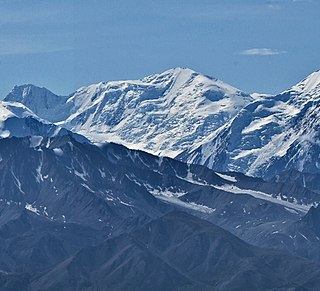
Mount Silverthrone is 13,220 ft (4,030 m) glaciated mountain summit located in Denali National Park and Preserve, in the Alaska Range, in the U.S. state of Alaska. It is situated 10.8 mi (17 km) east of Denali. The first ascent of this peak was made April 12, 1945, by Norman Bright and Frank P. Foster. It was so named by the U.S. Army Forces Cold Weather test party because of its stately appearance at the head of Brooks Glacier.
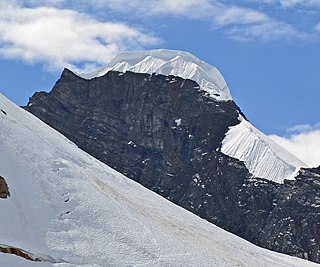
Pease Peak is a 7,750 ft (2,360 m) mountain summit located in the Alaska Range, in Denali National Park and Preserve, in the U.S. state of Alaska. It is situated 1,500 feet above the Tokositna Glacier to its west, and Ruth Glacier to the east, along the southern margin of the Don Sheldon Amphitheater, 11 mi (18 km) southeast of Denali, 2.84 mi (5 km) southeast of The Rooster Comb, and 0.45 mi (1 km) west of Mount Dickey, which is the nearest higher peak. Dickey forms the eastern buttress of Pittock Pass, whereas Pease forms the western buttress. Although overlooked as a climbing destination, the peak is often seen due to its proximity to the air taxi landing area and the Sheldon Chalet immediately north of the peak. Pease Peak, and its variant name Mount Pease, is based on a mountain climber's name that was published in the late 1940s.

Double Peak is a prominent 6,818 foot mountain summit located in Lake Clark National Park and Preserve, in the Chigmit Mountains of the Aleutian Range, in the US state of Alaska. It is the highest non-volcanic peak in the Chigmit Mountains, and third-highest overall. The mountain is situated immediately north of Double Glacier, 100 mi (161 km) west-southwest of Anchorage, and 17.74 mi (29 km) north-northeast of Redoubt Volcano, which is the nearest higher peak. Although modest in elevation, relief is significant since the mountain rises up from tidewater at Cook Inlet in about 20 miles, and it ranks 71st in prominence for all peaks in Alaska. Double Peak was considered to be a volcano by the International Association of Volcanology and Chemistry of the Earth's Interior in 1973, but subsequent reconnaissance mapping indicates the peak is likely made of plutonic rocks of Jurassic age.

Black Peak is a prominent 6,385-foot (1,946-meter) glaciated mountain summit located in Lake Clark National Park and Preserve, in the Chigmit Mountains of the Aleutian Range, in the US state of Alaska. It is the second-highest non-volcanic peak in the Chigmit Mountains, and fourth-highest overall. The mountain is situated 22 mi (35 km) west of Cook Inlet, 90 mi (145 km) west-southwest of Anchorage, and 10.2 mi (16 km) northeast of Double Peak, which is the nearest higher peak. Although modest in elevation, relief is significant since the mountain rises up 6,200 feet from North Fork Big River in about two miles. The mountain's descriptive name was published in 1912 by the United States Coast and Geodetic Survey. The months May through June offer the most favorable weather for viewing or climbing the peak.

Gunsight Mountain is a prominent 6,441-foot (1,963 m) elevation summit located 56 mi (90 km) northeast of Palmer in the Talkeetna Mountains of the U.S. state of Alaska. This landmark is set midway between Palmer and Glennallen, with the Glenn Highway traversing the southern base of this mountain. This remote mountain is situated at the east end of Sheep Mountain, and 12.2 mi (20 km) northeast of Mount Wickersham, its nearest higher peak. The mountain's descriptive local name was reported in 1952 by U.S. Geological Survey, and derives from a conspicuous deep notch in the summit ridge which has the appearance of a gunsight. This mountain is called Siz'aani, meaning "Heart", in the Ahtna language.

Matanuska Peak is a 6,093 ft (1,860 m) mountain summit located in the Chugach Mountains, in Matanuska-Susitna Borough in the U.S. state of Alaska. The mountain is a major landmark in the Matanuska Valley, situated 7.5 mi (12 km) east of Palmer, and 10 mi (16 km) north-northeast of Pioneer Peak. The nearest higher peak is Frontier Peak, 2.1 mi (3 km) to the southeast. Matanuska Peak's name was officially approved in 1969 by the United States Geological Survey, and derives from the Matanuska River, a native name on maps since 1897. "Matanuska" is derived from the Russian term for the "copper river people". The Matanuska Peak Trail is a five mile one-way hike with 5,670 feet of elevation gain and minor scrambling. The months June through October offer the most favorable weather and snow-free trail conditions to climb this peak. The Matanuska Peak Challenge is a strenuous race run in August each year.

Granite Peak is a 6,729-foot (2,051 m) elevation summit located 16 mi (26 km) northeast of Palmer in the southern Talkeetna Mountains of the U.S. state of Alaska. This landmark of the Matanuska Valley is set midway between Palmer and Chickaloon, with the Glenn Highway traversing the southern base of this mountain. This mountain is situated 6 mi (10 km) north of Sutton, and 13 mi (21 km) north of Matanuska Peak. The mountain's descriptive local name was reported in 1946 by U.S. Geological Survey, and officially adopted that same year by the U.S. Board on Geographic Names. This mountain is called Hdighilen Dghilaaye' in the Ahtna language.
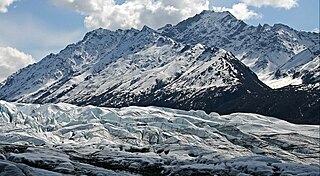
Mount Wickersham is a 7,415-foot (2,260 m) elevation mountain summit located 48 mi (77 km) east of Palmer, in the northern Chugach Mountains of the U.S. state of Alaska. This landmark of the Matanuska Valley is set midway between Anchorage and Glennallen, at mile 101 of the Glenn Highway. It is situated immediately west of Matanuska Glacier, and 10.5 mi (17 km) east of Amulet Peak. The mountain was named in 1960 by Senator Bob Bartlett and Secretary of the Interior Fred A. Seaton, to remember James Wickersham (1857–1939), attorney, District Judge, and Territorial Delegate to Congress from Alaska. In June 1903, Wickersham was also leader of the (unsuccessful) first attempt to climb Denali. His attempt was stymied by steep cliffs which also now bear his name, Wickersham Wall.

Kings Mountain, also commonly called King Mountain, is a prominent 5,809-foot (1,771 m) elevation mountain summit located 22 mi (35 km) northeast of Palmer, in the northwestern Chugach Mountains of the U.S. state of Alaska. This landmark of the Matanuska Valley is set between Anchorage and Glennallen, at mile 75 of the Glenn Highway. It is situated 18 mi (29 km) west of Amulet Peak, and 12 mi (19 km) east-southeast of Granite Peak. The mountain was named after Al King, a prospector who had a cabin nearby at the confluence of Kings River and Matanuska River. The name was used by prospectors, reported about 1905 by the U.S. Geological Survey, and officially adopted in 1906 by the U.S. Board on Geographic Names. This peak is known as Bashtl'ech' in the Denaʼina language, and Bes Tl'ets' in the Ahtna language, meaning "black stone".

Sheep Mountain is a 6,223-foot (1,897 m) elevation summit located 50 mi (80 km) northeast of Palmer in the southern Talkeetna Mountains of the U.S. state of Alaska. This landmark is set midway between Palmer and Glennallen, with the Glenn Highway traversing the southern base of this mountain at mile 113. The mountain is situated 1.6 mi (3 km) west-southwest of Gunsight Mountain, and 10.75 mi (17 km) northeast of Mount Wickersham. The mountain's local name was reported in 1906 by U.S. Geological Survey. It is called Beznae, meaning "(a type of) Stone", in the Ahtna language.

Sugar Loaf Mountain, also known as Sugar Mountain, is a 4,784 ft (1,460 m) summit located in the Alaska Range, near Denali National Park and Preserve, in Alaska, United States. It is situated 6 mi (10 km) northeast of park headquarters and 6 mi (10 km) southeast of Healy. The George Parks Highway and Alaska Railroad traverse the western base of this mountain as each passes through the Nenana River Gorge. Mount Healy, Sugar's nearest higher neighbor, is set 5.2 mi (8 km) to the west across the gorge. This peak's local descriptive name was published in 1950 by the United States Geological Survey.

Mount Eielson is a 5,802 ft (1,770 m) summit located in the Alaska Range, in Denali National Park and Preserve, in Alaska, United States. It is situated immediately east of the Muldrow Glacier terminus, 3.5 mi (6 km) south of Eielson Visitor Center, and 3.9 mi (6 km) north of Red Mountain, its nearest higher neighbor. Originally called Copper Mountain, this mountain was renamed by the U.S. Congress on June 14, 1930, to honor Carl Ben Eielson (1897–1929), for the pioneering work in aviation he performed in Alaska. Ben Eielson made the first airplane landing near Copper Mountain in Mount McKinley National Park, as it was known at that time.

Scott Peak is an 8,828 ft (2,690 m) glaciated mountain summit located in Denali National Park and Preserve, on the crest of the Alaska Range, in the U.S. state of Alaska. It is situated 9 mi (14 km) southeast of the Eielson Visitor Center, at the head of the Sunset Glacier, and 33.5 mi (54 km) northeast of Denali. This mountain was named in 1953 by Reynold E. (Pete) Isto of the U.S. Geological Survey and Bradford Washburn to honor Lieutenant Gordon D. Scott (1925–1953), a surveyor for the United States Coast and Geodetic Survey who was killed in a plane crash during mapping operations of this area. Scott Peak is set ten miles south of where the crash occurred near the Stony Creek Bridge area of the park road on June 11, 1953. Established climbing routes on Scott Peak include the Northeast Face, Northwest Face, and the Sunset Glacier. The first ascent of this peak was made in 1953 by Bradford Washburn.

Divide Mountain is a 5,195 ft (1,580 m) summit located in Denali National Park and Preserve, in the Alaska Range, in the U.S. state of Alaska. It is a landmark in the Toklat River valley visible to tourists from the park road. Divide Mountain is situated 2 mi (3 km) southwest of Polychrome Pass, 3.44 mi southwest of Polychrome Mountain, and 11 mi (18 km) north-northeast of Scott Peak. Although modest in elevation, relief is significant since the peak rises over 2,000 ft (610 m) from the surrounding valley floor. This mountain's local descriptive name was first shown on a 1916 U.S. Geological Survey map.

Polychrome Mountain is a prominent 5,900+ ft elevation summit located in Denali National Park and Preserve, in the Alaska Range, in the U.S. state of Alaska. It is a landmark in the Toklat River valley visible to tourists as the park road traverses the southern slope of the mountain. Polychrome Mountain is situated one mile north of Polychrome Pass, and 3.44 mi (6 km) northeast of Divide Mountain. Although modest in elevation, relief is significant since the peak rises nearly 3,000 ft (910 m) above the surrounding valley floor in less than two miles. This mountain's descriptive name, meaning "many colors", was first published in 1954 by the U.S. Geological Survey, and is taken from the pass with the same name.
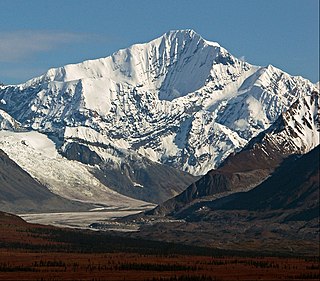
Hess Mountain, also known as Mount Hess, is an 11,940 ft (3,640 m) elevation glaciated summit located on the crest of the Alaska Range, in Alaska, United States. It is the seventh-highest peak in the Hayes Range, a subset of the Alaska Range. This remote peak is situated 13.3 mi (21 km) west of Mount Hayes, and 90 mi (145 km) south of Fairbanks. Mount Deborah, the nearest higher neighbor, is positioned 2.8 mi (5 km) to the west. The mountain's name was reported in 1912 by the United States Geological Survey. The first ascent was made May 24, 1951, by Alston Paige, Dick Holdren, Ed Huizer, Howard Bowman, and Elton Thayer. The first ascent via the North Ridge was made May 23, 1976, by Steven Hackett and Thomas Hillis.
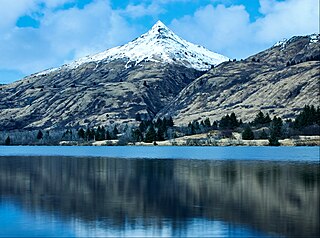
Pyramid Mountain is a 2,395-foot (730-meter) elevation mountain summit located on Kodiak Island in the US state of Alaska. The mountain is situated 7.5 mi (12 km) west of Kodiak. Although modest in elevation, relief is significant since the peak rises over 2,300 feet above Buskin Lake in only 1.5 mi (2 km). This peak's descriptive name was first published in 1943 by the United States Coast and Geodetic Survey. Based on the Köppen climate classification, Pyramid Mountain is located in a subpolar oceanic climate zone with cold winters and cool summers. Summer months offer the most favorable weather for climbing the peak via an established two-mile trail.

Mount Carmack is a prominent 6,808-foot-elevation (2,075-meter) mountain summit located in the Boundary Ranges of the Coast Mountains, in the U.S. state of Alaska. The peak is situated 7 mi (11 km) north-northeast of Skagway, and 3.5 mi (6 km) south of Mount Cleveland, on land managed by Tongass National Forest. As the highpoint on the divide between the Taiya River and the Skagway River, precipitation runoff from the mountain drains east into the Skagway River and west into Taiya River, both of which empty into Taiya Inlet. Although modest in elevation, relief is significant since Mount Carmack rises 6,800 feet above the Taiya valley in less than 2 mi (3 km), and 5,800 feet above Skagway valley in about 2 miles. Mount Carmack has a lower subsidiary summit, elevation 6,621 ft (2,020 m), about 0.5 mi (1 km) to the northeast of the true summit. The USGS map has this lower northeast peak labelled as Mount Carmack.

Mount Healy, also known in Denaʼina language as Dlel Neelghu Nodaadlghunee, is a 5,716-foot elevation mountain summit located in the Alaska Range, in Denali National Park and Preserve, in Alaska, United States. It is situated immediately northwest of park headquarters and 6 mi (10 km) south of Healy. The George Parks Highway and Alaska Railroad traverse the eastern base of this mountain as each passes through the Nenana River Gorge. Mount Healy's nearest neighbor, Sugar Loaf Mountain, is set 5.2 mi (8 km) to the east across the gorge, and the nearest higher peak is Fang Mountain, 16.2 mi (26 km) to the south-southwest. Mount Healy is a nine-mile-long, east–west trending ridge system of mostly loose rock with jagged peaks and spires. Vegetation ranges from boreal forest at the base all the way up to barren alpine ridges and snowfields at the top. This area is very popular for day hikes due to its close proximity to the park entrance. This mountain and the town are named after John J. Healy (1840–1908), manager of the North American Trading and Transportation Company. This geographical feature's name was reported in 1921 by Mabry Abbey on his survey map of the boundaries of Mount McKinley National Park.
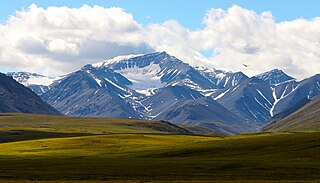
Mount Kiev is a 7,775-foot-elevation (2,370-meter) mountain summit located in Alaska, United States.






















